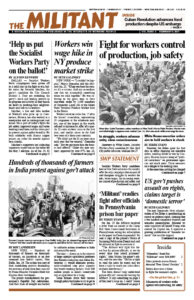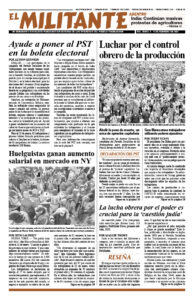Stepped-up measures imposed by the U.S. imperialist rulers as part of its economic war against the Cuban people and their socialist revolution are having a serious impact on the country’s agricultural production.
Sanctions on Venezuelan shipments of oil to Cuba, tighter restrictions on travel to the island from the U.S., limits on family remittances, and other obstacles to Cuba’s access to hard currency have reduced the government’s ability to import fuel, machinery parts, fertilizers and other agricultural inputs necessary for food production. The coronavirus pandemic has also sharply disrupted tourism, one of its top sources of hard currency.
“People could say that Cuba is an island with land, and has good weather, and can grow a lot of food,” Gerardo Hernández, one of the Cuban Five revolutionaries who had been imprisoned in the U.S. and is currently the national coordinator of the Committees for the Defense of the Revolution, explained in an interview with the Cuba Solidarity Campaign in the U.K. in December.
“But remember, to grow food you need a lot of chemicals, fuel, machinery, and all of that is very hard for Cuba to get because of the U.S. blockade.”
Rice and bean production has plunged, causing shortages of these two main staples of the Cuban diet.
The rice harvest fell back to 246,700 tons in 2019 — from a record high of 300,000 tons the year before. The goal for 2020 had to be adjusted further down to 163,000 as use of airplanes for seeding and fumigation, harvesters, and irrigation systems was cut back due to shortages.
Cuba needs 700,000 tons of rice every year to meet the nation’s needs. What they can’t grow has to be imported at world market prices, and then is sold at subsidized prices.
Since 2010 the Cuban government has dedicated major economic resources to working with farmers through their organization — the National Association of Small Farmers (ANAP) — to increase rice production in order to reduce imports. But the sanctions imposed by the Donald Trump administration reversed the upward production trend in the country’s rice industry.
These measures are likely to remain in place for the foreseeable future under the Democratic Party administration of Joe Biden, which is committed to continuing economic pressure against the revolution.
U.S. companies are prohibited from offering credit to Cuban entities. This means agricultural sales must be made on a cash-on-delivery basis, rather than the normal terms of international trade.
Cuba is forced to purchase products and equipment at a much higher cost, often from sources far afield. For example, it takes 36 days for rice purchased from Vietnam to travel to Cuba, while it only takes 36 hours if purchased in the U.S. This means having to use much-needed foreign currency that could have been allocated to the country’s development.
Bean production has also taken a serious blow. The Cuban press reported last August that only 58,000 acres were cultivated because of lack of fuel. There was enough fertilizer to cover only 8% of the total area sown, and only 16% was treated with chemical pesticides.
To make matters worse, a plague hit the bean fields last year, which did substantial damage. The country’s yearly consumption is 70,000 tons. Average production in the last three years had been around 51,000 tons.
Power of Cuban peoples’ revolution
The U.S. economic war against Cuba has no parallel. It began in 1960, less than a year after the Cuban people, led by Fidel Castro and the July 26 Movement, overthrew the U.S.-backed dictatorship of Fulgencio Batista. They mobilized millions of workers and peasants to take political power and build a new society based on the needs of the producing classes.
Before working people took power in Cuba, an enormous percentage of the Cuban economy was under the control of U.S. corporations. This was broken when the revolution nationalized the land and workers and farmers carried out an agrarian reform. U.S. companies had controlled a significant portion of the country’s natural resources, including sugar, cattle, tobacco, timber, oil, mining and farm industries.
The nationalization guaranteed the land to the tillers and the land reform guaranteed jobs for hundreds of thousands of agricultural workers. The crushing debt slavery that farmers suffered under capitalism was abolished by the revolution. This meant farmers can’t be subject to foreclosure.
Since then ANAP and other Cuban mass organizations like the CDRs have played a key role in opening possibilities for farmers to increase production. As with all questions Cuba’s revolutionary government looks to the country’s workers and farmers for solutions to the challenges they face.
Simultaneously with the efforts to increase national food production, working people and youth in Cuba are organizing a campaign for neighborhoods and work centers to grow their own food.
“If the U.S. imperialists have been trying to kill us of hunger for more than 60 years — without a pandemic — well, now they are going to try to do it even more,” CDR leader Hernández explained on Cuban television last June.
“So we’re asking everyone to grow food everywhere possible, to make the most of every little plot of land,” he said. “So that everyone can contribute not only to their own consumption but also everyone’s consumption.”
Hernández reported five months later, “I am happy to tell you the initiative is very popular.”

